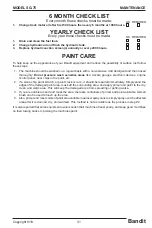
Bandit
28
Copyright 8/19
MODEL SG-75
MAINTENANCE
15. Check oil cooler:
Thoroughly clean cooler fins at least once a day
or more in excessive conditions. Make sure debris
is not packed between fins. Use compressed air
and/or pressurized water (soap may also be needed)
to clean the oil cooler, depending on the level and
type of debris. If pressurized water is used, be careful
not to turn the debris hard and pack solid between
thecoolerfins.Makesuretocleanthecoolerinthe
correctdirection;donotpropelthedebrisintothe
cooler with compressed air or pressurized water.
Keep the compressed air or pressurized water a
safedistancefromthecoolerfinssotheyarenot
damaged.Visuallyinspectthecoolerfinsandmake
suretheyarenotbentorclosedoff,repairorreplace
as needed.
16. Check air cleaner and precleaner:
Clean or replace element following engine manual
recommendations. Also, check and clean the
vacuator valve.
17. Check machine controls:
Operate all machine controls and ensure they
operate smoothly and shift correctly.
18. Inspect, and adjust tracks:
Check track tension, there must be no slack between
the track rollers and the track rubber. For more
detailed instructions, see page 35. Also, check
tracks for wear, weather checking, and damage.
Replace if damaged.
19. Lubricate track expansion assembly:
Apply dry lube to track expansion tubes daily.
20. Check around machine:
Check around the entire machine for tools, cans,
saws, etc. All tools not in use should be stored in
a tool box.
21. Review all safety procedures on decals, from
manual, and from video.
22. Make sure all safety equipment is being worn:
Make sure you are wearing all of your safety
equipment: hard hat, face shield, gloves, eye
protection, ear protection, etc. per ANSI and OSHA
standards.
23. Remember to check EVERYTHING on the
checklist.
10. Check hydraulic oil level:
The hydraulic oil reservoir tank level should always
remain at 7/8 full. Remember to check DAILY to avoid
excessive heat build up.
11.
Check for any fluid leaks:
Inspect for any oil, fuel, hydraulic oil, or engine
coolantleaks.Checkallhoses,fittings,lines,and
tanks. DO NOT use fingers or skin to check for
hydraulic leaks. Repair or replace any damaged or
leaking components.
12. Check the fuel level:
Check the fuel level, running out and repriming is
timeconsuming.Donotoverfill,andyoumustleave
fuel expansion space in the top of the tank.
13. Check engine oil and coolant level:
F o l l o w t h e e n g i n e m a n u f a c t u r e r m a n u a l
recommendations for fluid levels. You MUST
follow specific engine manufacturer’s manual
recommendations for radiator coolant, additives,
lubrication, correct engine speed, etc.
14. Check radiator, debris screen:
Refer to the engine manufacturer’s manual.
Thoroughlycleanradiatorfinsatleastonceaday
or more in excessive conditions. Make sure debris
is not packed between fins. Use compressed air
and/or pressurized water (soap may also be needed)
to clean the radiator, depending on the level and type
of debris. If pressurized water is used, be careful not
to turn the debris hard and pack solid between the
radiatorfins.Makesuretocleantheradiatorinthe
correct direction depending on if the cooling fan is
asuckerorapusher;donotpropelthedebrisinto
the radiator with compressed air or pressurized
water. A partially plugged radiator will not allow the
engine to cool properly. Keep the compressed air or
pressurized water a safe distance from the radiator
fins so they are not damaged. Visually inspect
theradiatorfinsandmakesuretheyarenotbent
or closed off, repair or replace as needed. Clean
cooling fan, shroud on air cooled engines, and the
debris screen (if so equipped). Improper service,
maintenance, or neglect will cause overheating
problems and/or engine failure.
DAILY START UP & MAINTENANCE (cont.)
1. Lubricate all steel friction areas:
Lubricate all steel friction areas including, but not
limited to pivoting, hinged, sliding, rotating areas
on the machine (i.e. cutter wheel guard, control box
doors, etc.).
2. Check alternator and fan belts on engine (as
applicable):
Adjust and maintain per the engine manufacturer’s
manual.
WEEKLY MAINTENANCE
















































